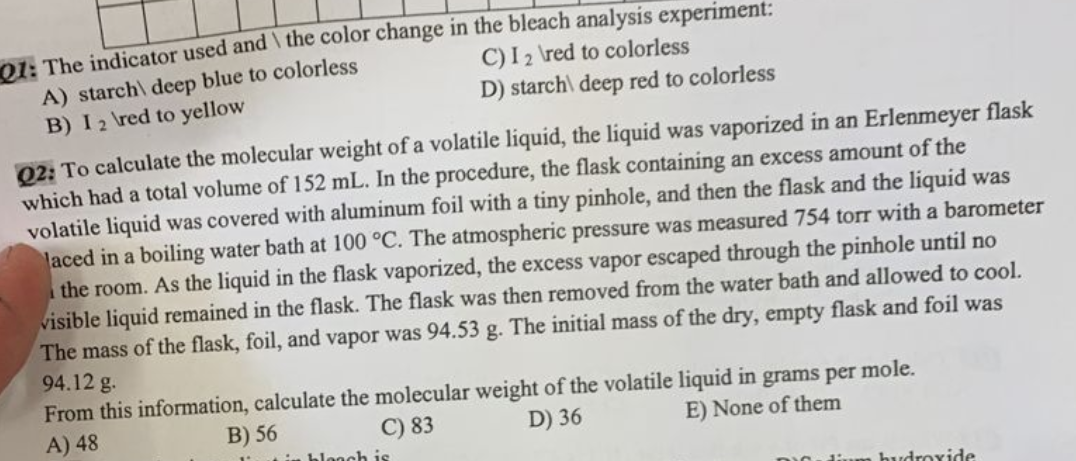B) I 2 \red to yellow 02: To calculate the molecular weight of a volatile liquid, the liquid was vaporized in an Erlenmeyer flask which had a total volume of 152 mL. In the procedure, the flask containing an excess amount of the volatile liquid was covered with aluminum foil with a tiny pinhole, and then the flask and the liquid was laced in a boiling water bath at 100 °C. The atmospheric pressure was measured 754 torr with a barometer the room. As the liquid in the flask vaporized, the excess vapor escaped through the pinhole until no visible liquid remained in the flask. The flask was then removed from the water bath and allowed to cool. The mass of the flask, foil, and vapor was 94.53 g. The initial mass of the dry, empty flask and foil was 94.12 g. From this information, calculate the molecular weight of the volatile liquid in grams per mole. E) None of them D) 36 A) 48 B) 56 C) 83 blanch is hudroxide
B) I 2 \red to yellow 02: To calculate the molecular weight of a volatile liquid, the liquid was vaporized in an Erlenmeyer flask which had a total volume of 152 mL. In the procedure, the flask containing an excess amount of the volatile liquid was covered with aluminum foil with a tiny pinhole, and then the flask and the liquid was laced in a boiling water bath at 100 °C. The atmospheric pressure was measured 754 torr with a barometer the room. As the liquid in the flask vaporized, the excess vapor escaped through the pinhole until no visible liquid remained in the flask. The flask was then removed from the water bath and allowed to cool. The mass of the flask, foil, and vapor was 94.53 g. The initial mass of the dry, empty flask and foil was 94.12 g. From this information, calculate the molecular weight of the volatile liquid in grams per mole. E) None of them D) 36 A) 48 B) 56 C) 83 blanch is hudroxide
Chapter3: Statistical Tests With Excel
Section: Chapter Questions
Problem 6P
Related questions
Question
pleeeeeeease solve question 2

Transcribed Image Text:Q1: The indicator used and the color change in the bleach analysis experiment:
C) I 2 \red to colorless
A) starch\ deep blue to colorless
B) I2 \red to yellow
D) starch\ deep red to colorless
02: To calculate the molecular weight of a volatile liquid, the liquid was vaporized in an Erlenmeyer flask
which had a total volume of 152 mL. In the procedure, the flask containing an excess amount of the
volatile liquid was covered with aluminum foil with a tiny pinhole, and then the flask and the liquid was
laced in a boiling water bath at 100 °C. The atmospheric pressure was measured 754 torr with a barometer
the room. As the liquid in the flask vaporized, the excess vapor escaped through the pinhole until no
visible liquid remained in the flask. The flask was then removed from the water bath and allowed to cool.
The mass of the flask, foil, and vapor was 94.53 g. The initial mass of the dry, empty flask and foil was
94.12 g.
From this information, calculate the molecular weight of the volatile liquid in grams per mole.
A) 48
B) 56
C) 83
D) 36
E) None of them
in blanch is
hydroxide
Expert Solution
This question has been solved!
Explore an expertly crafted, step-by-step solution for a thorough understanding of key concepts.
Step by step
Solved in 3 steps with 3 images

Knowledge Booster
Learn more about
Need a deep-dive on the concept behind this application? Look no further. Learn more about this topic, chemistry and related others by exploring similar questions and additional content below.Recommended textbooks for you


Principles of Instrumental Analysis
Chemistry
ISBN:
9781305577213
Author:
Douglas A. Skoog, F. James Holler, Stanley R. Crouch
Publisher:
Cengage Learning


Principles of Instrumental Analysis
Chemistry
ISBN:
9781305577213
Author:
Douglas A. Skoog, F. James Holler, Stanley R. Crouch
Publisher:
Cengage Learning